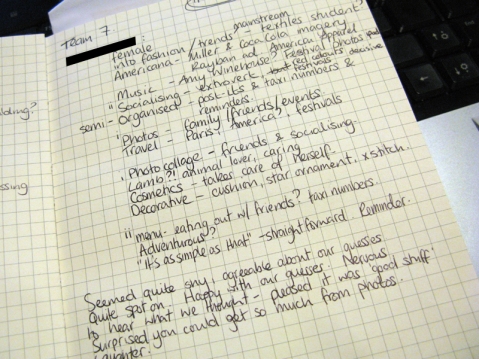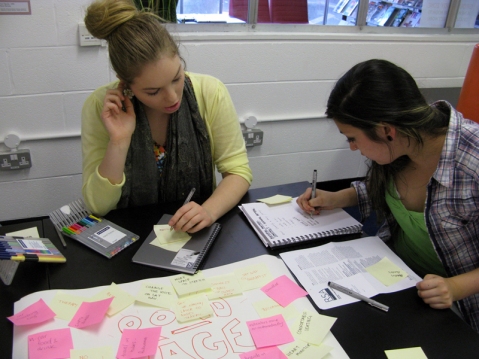Assignment 1: Are You What You Wear?
The first workshop of my new module (21st Century Designer) was an exercise in snooping. We’d previously been asked to collect photographs from our childhoods or our homes, which we were to swap with classmates and analyse. I enjoyed this task; I like to think I’m quite good at figuring people out, but I’ve never had to try to do so without actually being face-to-face with the person! We were asked to think about what this person might be like, what their upbringing might have been like, what subject they are studying, what sort of personality they might have – in other words, we weren’t to just note down what we see (fictional example: clothes everywhere) but why it’s there (clothes everywhere might mean an interest in trends and fast, inexpensive fashion, someone who enjoys shopping either socially or as an individual exercise, who feels their clothing/look is very important in terms of self-expression, someone who is untidy or disorganised, or any number of other things).
My team (team 8) only had two sets of photos to examine, so we were able to give a fair amount of time to each. Here are my notes for each of them:
As you can see, we noted down various basic things that we could see in the pictures, like “photos”, “music”, “birthday party”. We then tried to figure out what these things meant in relation to someone’s whole personality. We thought our first student (who provided pictures of their student halls bedroom) was female, a textile design student, quite mainstream and into fashion and trends, who enjoys socialising and travelling. She seemed to have a particular interest in Americana, with Coca-Cola, Miller, American Apparel, and Ray-Ban ads in a sort of photo collage on one wall. We spotted photographs from a music festival, so we thought she would be quite into music and taking part in new experiences, and socialising in large groups. We also thought she would be quite extroverted, from her bold choice of red bedding and a cushion that was mainly red, the photographs of her with groups of friends, and an image in the aforementioned photo collage was of someone leaping off a cliff. We also thought she would be quite organised, because next to a desk we could see a number of Post-It notes, reminders, a restaurant menu, and a taxi company phone number. Along with being extroverted, we thought she would be quite straightforward in approaching things, because part of her photo collage was an ad that stated “as simple as that” and we thought it might serve as a sort of motivational poster. Straightforward though she might be, we also thought she’d be a very caring person and a bit of an animal lover, as evidenced by all the photos she keeps around her, a decorative cushion with a dog on it, and the fact that she provided a photo of a lamb in her kitchen or utility room (which also led us to believe she lived on or near a farm back home).
Our second student provided childhood photos, which we found more difficult to work with. I’m not great at gauging ages, but I think the photos were taken between the ages of about six and ten, and they mostly seemed to be from at-home birthday parties. We took from these pictures that the student was female, quite feminine, and a textile design student. The at-home birthday parties led us to believe she came from a very caring, quite affluent background – the house appeared to be quite big, with a room large enough to accommodate a lot of excited children and their parents, and some party games. We could also see quite a nice garden and some patio furniture, which reinforced our assumption. We thought she’d be quite sociable, as there were both boys and girls in the party photos, but of course at that age the children could have just been family (which would reinforce our ideas about the family being very caring) or it might have simply been that her whole school class was invited to the party. A photo of her and another girl (who we thought to be her sister) at a park feeding ducks, along with the party photos gave the impression of her having had quite an idyllic upbringing. In none of the pictures was our student in the forefront, seeking attention; in fact, in one photo she was facing away and holding onto her mother, apparently hiding from or at least avoiding the camera, so we thought she would be quite a reserved character.
We later met up with the team whose photos we’d examined, and swapped analyses with them. It was quite interesting to see how people reacted to our guesses, and I think we were all excited to find if we were correct. It turns out that we were all (mostly) rather good at this snooping lark.
Team 7 seemed quite happy with our guesses, although our assumption that our second student was reserved was wrong – she told us that as a child she was often very much the centre of attention and would perform for any audience, so I suppose candid snapshots aren’t always the most revealing about someone’s personality.
There was a bit of nervous laughter, and everyone seemed really keen to hear what was to be said about them, sometimes perhaps a little guarded. I felt a bit apprehensive, but that’s just my default reaction to new things! I mean, really, what’s the worst thing that could be guessed from my photos?
I provided photos from my living room, and was quite excited to hear team 7’s guesses about me. They were pretty spot on, actually. Female, 23+, textile design student, flat shared with a boyfriend, keep a lot of “stuff” – cutesy trinkets, small toys, etc., very into learning – they thought learning and education would have probably been very important at home and something that I’ve carried on, would probably rather stay in and watch a film than go out clubbing – this is very true, evidenced by our massive DVD collection (which probably also proves that I like to “keep stuff” and “have things”), and I’m usually happy to say that I’m a stay-er-in-er but coming from someone else it sounds quite boring.
The way I felt about inspecting someone else’s life and having my own life inspected differed quite a bit, which surprised me. I didn’t feel bad or awkward looking at the pictures, because I didn’t imagine that anyone would show pictures that they didn’t want anyone to see. However, when I was trying to choose my own pictures to show, I found it quite difficult – I examined every shot and hemmed and hawed over what people might think of them. Of course it didn’t really matter in the end – everyone showed pictures (I assume) they were happy to show, and I didn’t really mind that I hadn’t dusted, that my shelves are cluttered with things, that there’s bits of unfinished knitting floating around, and the occasional empty envelope that hasn’t quite made its way to the bin. I suppose that’s the whole point of the exercise, really – this is how I we are, whether we like it or not!
In terms of ethics, there are lots of considerations to make in regards to snooping. We had it quite easy, as everyone had the choice of what pictures to show, or even not to provide pictures of their own. I suppose at the very least, in cases like ours, people have to know about and agree to you looking into their lives.
As part of this assignment we’ve been asked to research the Johari window, something I’d never heard of before. It’s a technique often used in a self-help capacity to help people increase their personal awareness, by placing adjectives chosen by both the subject and his or her peers in place on a grid. It is definitely going to take a bit more in-depth reading to fully understand. I found an interactive Johari window floating around the depths of the internet, which might be quite an interesting thing to explore.
Assignment 2, part 1.
Last Friday as part of Change by Design we were split into teams of around five people and introduced to the concept of brainstorming as a way to come up with ideas, names, solutions, designs, anything. We were encouraged to brainstorm in two different ways – either by every team member writing ideas on Post-Its and shouting out their ideas, or by having one team member nominated as a scribe to write down all the ideas of the other team members. I think I preferred the Post-It method – everybody is allowed the same level of input, and hearing other peoples’ ideas shouted out often inspires new ideas to pop into your head.
Today I met with my team to work on the 2nd Change by Design assignment. For this assignment, each team was given a brief at random from the RSA’s Student Design Awards. We got brief 8 – The Good Journey (PDF). “Make people look forward to their daily commute.” is the theme to work to.
We did a bit of brainstorming about what makes peoples’ daily commutes so stressful, and among such suggestions as uneven pavements, pavement hoggers, and drivers who don’t indicate, we settled on looking at road rage in more detail. I don’t think people would mind quite so much the daily car journeys if only there were ways to instantly relieve your stress or anger whilst you were still experiencing it.
We then brainstormed to try to find the reasons why people get road rage, and to find solutions for it, coming up with things like in-car punching bags, squeezy stress balls installed in every car, and just having a chauffeur so that you don’t have to do any of the driving yourself. I, personally, like my suggestion of inventing mass transit tubes like in Futurama! We plan to meet up again soon to complete the assignment, discuss in more detail our ideas (I hope to come up with more – maybe over the next few days when I’m in the car I’ll think of something, because I get road rage even as a passenger!), and settle on one final solution to the ubiquitous road rage problem.
Although I was a bit dubious about being placed in a team with people I don’t know, I realise now that it can actually be very beneficial. It’s very refreshing to speak to people from different disciplines, who are interested in completely different subjects to me, and who will probably take away from this exercise some vastly different opinions and ideas to the ones I do.








